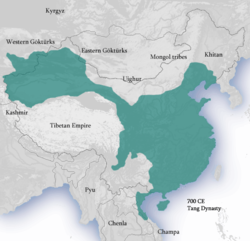
Back دودمان ژو دوم Persian 武周 GAN Vú-Chû HAK Dinasti Zhou Kedua ID 武周 Japanese 무주 (당나라) Korean Wu Zhou-dynastie Dutch Dinastia Zhou (690–705) Portuguese Вторая Чжоу Russian Zhou dynasty (690–705) SCO
Zhou 周 | |||||||||||||
|---|---|---|---|---|---|---|---|---|---|---|---|---|---|
| 690–705 | |||||||||||||
 Wu Zhou, c. 700 | |||||||||||||
| Status | Empire | ||||||||||||
| Capital | Shendu (Luoyang) | ||||||||||||
| Common languages | Chinese | ||||||||||||
| Religion | Buddhism (state religion), Taoism, Confucianism, Chinese folk religion | ||||||||||||
| Government | Absolute hereditary monarchy | ||||||||||||
| Emperor of China | |||||||||||||
• 690–705 | Wu Zetian | ||||||||||||
| History | |||||||||||||
• Established by Wu Zetian | 17 October[1] 690 | ||||||||||||
| 21 February[2] 705 | |||||||||||||
| Currency | Chinese coin, Chinese cash | ||||||||||||
| |||||||||||||
| Part of a series on the |
| History of China |
|---|
Zhou, known in historiography as the Wu Zhou (Chinese: 武周), was a short-lived Chinese imperial dynasty that existed between 690 and 705. The dynasty consisted of the reign of one empress regnant, Wu Zhao (Wu Zetian), who usurped the throne of her son, the Emperor Ruizong of Tang, in 690. The dynasty lasted until another one of Wu Zhao's sons, the Emperor Zhongzong of Tang, was restored to the throne in the Shenlong Coup in 705, marking the restoration of the Tang dynasty. Historians generally regard the Wu Zhou as an interregnum of the Tang dynasty.
Wu named her dynasty after the ancient Zhou dynasty, from whom she believed herself to be descended.

- ^ Twitchett, Denis. Chen gui and Other Works Attributed to Emperor Wu Zetian (PDF). p. 20.
- ^ Twitchett, Denis. Chen gui and Other Works Attributed to Emperor Wu Zetian (PDF). p. 71.